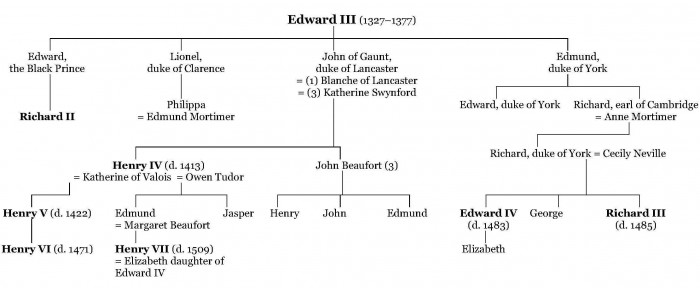
BackgroundThe Yorkists and the Lancastrians were two branches of the same family: the family of Edward III (see also The Hundred Years’ War: Background).
The eldest son of Edward III was Edward, the Black Prince, who died in 1376 and was succeeded as king by his son Richard II. In 1399 Richard was deposed by his cousin Henry Bolingbroke, the son of Edward III’s third son, John of Gaunt, duke of Lancaster, who then became King Henry IV and was succeeded as king of England by his son Henry V and grandson, Henry VI. However, although Richard II had died without an heir in 1400, there were many other descendants of Edward III. Edward’s second son, Lionel, duke of Clarence, had a daughter named Philippa who married Edmund Mortimer, earl of March (died 1381). Their granddaughter, Anne Mortimer, married Richard, earl of Cambridge, the son of Edward III’s fourth son Edmund, duke of York. Anne and Richard’s son, namely Richard, duke of York, was therefore descended from Edward III on both his mother’s and his father’s side, and his claim to the Crown could be said to be stronger than that of the Lancastrian kings. Even so, Richard fought for Henry VI’s interests in France in the final phase of the Hundred Years War (and it was in his army that Guto’r Glyn enlisted in 1441, see The Hundred Years War: Guto and the War). When Henry V had won the battle of Agincourt in 1415, he gained a reputation as a successful leader and subsequently secured great support as king of England. He died young, however, in 1422, when his son was just a baby. Henry VI became king of England and when his grandfather on his mother’s side, Charles VI, king of France, died less than two months later, he also inherited his crown, according to the terms of the Treaty of Troyes (see The Hundred Years’ War: Background). However, in years to come it became apparent that he was a much weaker figure than his father, and he also suffered from bouts of mental illness. Henry was strongly influenced by those around him, and fierce rivalries developed between Richard, duke of York, along with his brother-in-law Richard Neville, earl of Warwick, on the Yorkist side, and, on the Lancastrian side, Henry VI’s queen, Margaret of Anjou, and Edmund Beaufort, duke of Somerset. Edmund Beaufort was another descendant of John of Gaunt, and had replaced Richard of York as Henry VI’s commander in France. His connection with Henry VI was further strengthened when his niece, Margaret Beaufort, married the king’s half-brother Edmund Tudor (the son of Henry V’s widow, Katherine, and a Welsh gentleman, Owen Tudor; see Wales and the Wars). By March 1454 it had become clear that Henry VI could not fulfil his duties as king, and Richard, duke of York, was appointed Protector of the Realm. This opened many opportunities for Richard, including lessening the influence that Edmund Beaufort, duke of Somerset, had on Henry VI. However, in 1455 the king improved remarkably and Richard realized that his position as Protector of the Realm was at stake. Along with his allies, he plotted to regain his influence over the king by force of arms. [1] The king and Somerset learned of this and brought an army to confront the Yorkists at St Albans, a few miles north of London. In this battle, the first battle of the Wars of the Roses, the Yorkists were victorious and Edmund, duke of Somerset, was killed. Many more battles followed between the Lancastrians and the Yorkists. Richard, duke of York, was killed at the battle of Wakefield on December 30, 1460, but his son became King Edward IV in 1461 and reigned until his death in 1483, except for a brief period in 1470-1 when Henry VI was returned to power. Edward’s brother briefly ruled as King Richard III, but it was Henry Tudor, son of Margaret Beaufort and Edmund Tudor, who succeeded Richard, defeating him at Bosworth in 1485. Henry reigned as King Henry VII and founded the Tudor dynasty which would reign for over a hundred years. Bibliography[1]: For the duke’s career, see further P.A. Johnson, Duke Richard of York 1411-1460 (Oxford, 1988). |
Unless otherwise noted, copyright on the content of this website belongs to the University of Wales






